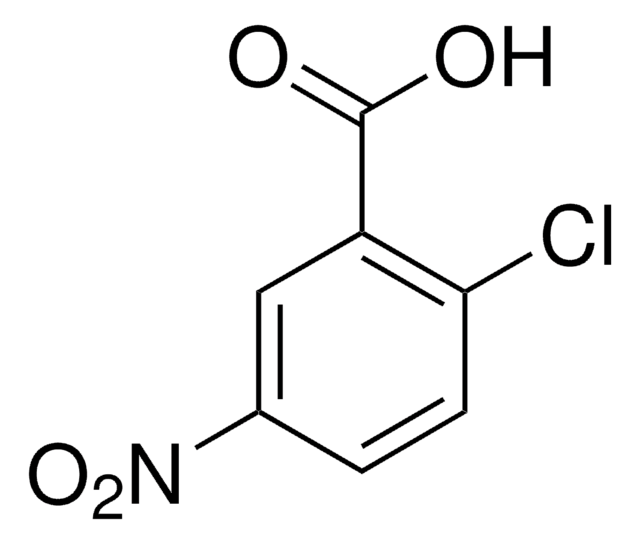135577
2-Chlorobenzoic acid
98%
Synonym(s):
2-CBA, o-Chlorobenzoic acid
Sign Into View Organizational & Contract Pricing
All Photos(1)
About This Item
Linear Formula:
ClC6H4CO2H
CAS Number:
Molecular Weight:
156.57
Beilstein:
907340
EC Number:
MDL number:
UNSPSC Code:
12352100
PubChem Substance ID:
NACRES:
NA.22
Recommended Products
Assay
98%
mp
138-140 °C (lit.)
solubility
cold water: soluble 900 part
alcohol: freely soluble
diethyl ether: freely soluble
water: soluble (hot)
functional group
carboxylic acid
chloro
SMILES string
OC(=O)c1ccccc1Cl
InChI
1S/C7H5ClO2/c8-6-4-2-1-3-5(6)7(9)10/h1-4H,(H,9,10)
InChI key
IKCLCGXPQILATA-UHFFFAOYSA-N
Looking for similar products? Visit Product Comparison Guide
Related Categories
General description
2-Chlorobenzoic acid degradation by pure cultures of Burkholderia cepacia strain with and without the bacterial hemoglobin gene was studied in parallel membrane bioreactors. Intramolecular hydrogen atom tunneling in 2-chlorobenzoic acid has been studied by low-temperature matrix-isolation infrared spectroscopy.
Application
2-Chlorobenzoic acid was used to study the degradation of 2-bromobenzoic acid by Pseudomonas aeruginosa.
Signal Word
Warning
Hazard Statements
Precautionary Statements
Hazard Classifications
Eye Irrit. 2 - Skin Irrit. 2
Storage Class Code
13 - Non Combustible Solids
WGK
WGK 2
Flash Point(F)
343.4 °F
Flash Point(C)
173 °C
Personal Protective Equipment
dust mask type N95 (US), Eyeshields, Gloves
Choose from one of the most recent versions:
Already Own This Product?
Find documentation for the products that you have recently purchased in the Document Library.
Customers Also Viewed
F K Higson et al.
Applied and environmental microbiology, 56(6), 1615-1619 (1990-06-01)
A strain of Pseudomonas aeruginosa producing 2-bromobenzoic acid, designated 2-BBZA, was isolated by enrichment culture from municipal sewage. It degraded all four 2-halobenzoates as well as certain 3-halo- and dihalobenzoates, though none of the 4-halobenzoates supported growth of this organism.
Grazia Baggi et al.
Biodegradation, 16(3), 275-282 (2005-05-04)
A study was made of the metabolic and co-metabolic intermediates of 2- and 3-chlorobenzoate, 2,3- and 3,5-dichlorobenzoate to elucidate the mechanism(s) involved in the negative effects observed on the growth of a chlorobenzoate-degrading microbial consortium in the presence of mixed
Gang-hua Lang et al.
Applied microbiology and biotechnology, 83(6), 1085-1094 (2009-03-26)
TfdT is a LysR-type transcriptional regulator that activates the transcription of the chlorocatechol degradative gene operon tfdCDEF of the chlorobenzoate-degrading bacterium Burkholderia sp. NK8. To identify the amino acids involved in the effector recognition by TfdT, a polymerase-chain-reaction-based random mutagenesis
A C Layton et al.
Journal of industrial microbiology, 13(6), 392-401 (1994-11-01)
The microbial populations in PCB-contaminated electric power substation capacitor bank soil (TVA soil) and from another PCB-contaminated site (New England soil) were compared to determine their potential to degrade PCB. Known biphenyl operon genes were used as gene probes in
C A Blackledge et al.
Journal of pharmaceutical and biomedical analysis, 22(6), 1023-1028 (2000-06-17)
The metabolic fate of [14C]-labelled 2 and 4-chlorobenzoic acids (2- and 4-CBA) has been determined in the rat following intraperitoneal (i.p.) administration at 100 mg/kg to male rats. The major route of elimination for both 2-and 4-CBA was urine with
Our team of scientists has experience in all areas of research including Life Science, Material Science, Chemical Synthesis, Chromatography, Analytical and many others.
Contact Technical Service











